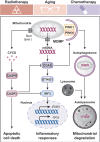Inflammation and mitophagy are mitochondrial checkpoints to aging
- PMID: 38643254
- PMCID: PMC11032393
- DOI: 10.1038/s41467-024-47840-1
Inflammation and mitophagy are mitochondrial checkpoints to aging
Abstract
Cellular and organismal aging have been consistently associated with mitochondrial dysfunction and inflammation. Accumulating evidence indicates that aging-related inflammatory responses are mechanistically linked to compromised mitochondrial integrity coupled with mtDNA-driven CGAS activation, a process that is tonically inhibited by mitophagy.
Conflict of interest statement
L.G. is/has been holding research contracts with Lytix Biopharma, Promontory, and Onxeo, has received consulting/advisory honoraria from Boehringer Ingelheim, AstraZeneca, OmniSEQ, Onxeo, The Longevity Labs, Inzen, Imvax, Sotio, Promontory, Noxopharm, EduCom, and the Luke Heller TECPR2 Foundation, and holds Promontory stock options. E.G. and K.A.S. have no conflicts of interest to declare.
Figures

References
MeSH terms
Grants and funding
LinkOut - more resources
Full Text Sources
Medical

